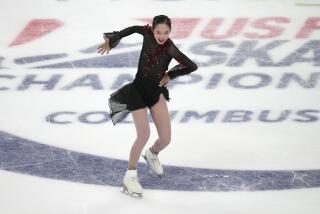Kuchiki-Sand Skating Team Facing Future of Uncertainty
- Share via
OAKLAND — Just one year after Natasha Kuchiki and Todd Sand emerged as the best hope for the future of U.S. pairs figure skating, it is now possible they will be history.
John Nicks, who coaches Kuchiki of Canoga Park and former Thousand Oaks resident Sand, said he will meet with them soon to discuss their next move.
He acknowledged that their eighth-place finish Thursday night at the Oakland Coliseum Arena in the World Championships, a competition in which they finished third last year, is an indication that they have lost their momentum.
“You can overcome that, but it’s difficult some times,” Nicks said. “When we talk, I’m going to be very open and very frank. I will lay it out factually and see what they feel about it.”
A meeting was held after last month’s competition in which referees and judges involved in the pairs competition critiqued the skaters.
Although he has not been able to confirm it in discussions with judges, Nicks said he heard the consensus was that neither Kuchiki and Sand nor the U.S. champions, Calla Urbanski of Skokie, Ill., and Rocky Marval of New Egypt, N.J., are believed to have bright futures as teams. Kuchiki, 15, and Sand, 28, finished sixth in the Olympics; Urbanski, 31, and Marval, 26, were 10th.
Reportedly receiving a favorable critique based on their potential were the 11th-place finishers, Jenni Meno, 21, of Westlake, Ohio, and Scott Wendland, 26, of Costa Mesa, who, like Kuchiki and Sand, train under Nicks in Costa Mesa.
But none of the three U.S. pairs were impressive in the World Championships. Urbanski and Marval finished seventh, one place ahead of Kuchiki and Sand, and Meno and Wendland again were 11th.
Because no U.S. competitors finished among the first five, the U.S. Figure Skating Assn. can enter only two pairs in next year’s World Championships in Prague, Czechoslovakia.
As recently as last winter, it would have been possible to imagine Kuchiki and Sand contending for a gold medal in Prague. Now, there is no guarantee they will make the U.S. team by finishing first or second in next year’s national championships even if they are still together.
If they are not together, it will bring to a close one of the more remarkable chapters in U.S. figure skating history.
Their rapid rise to prominence was little short of phenomenal considering that most successful pairs work together for several years before receiving international attention.
Pairs from the former Soviet Union, who have finished first 25 times in the World Championships in the last 28 years, often are teamed four or five years before they even enter a major international competition.
Nicks paired a 12-year-old Kuchiki with a 25-year-old Sand, who was living at the time in Thousand Oaks, in the spring of 1989, only nine months before they would finish second in the 1990 national championships.
Although Kuchiki was too young according to eligibility rules, the International Skating Union granted her a special waiver to compete at the 1990 World Championships in Halifax, Canada, where she and Sand finished 11th. One year later, they won the national championship and finished third in the World Championships.
But they began to slide this year, due at least in part to Sand’s lingering back problems that have made it difficult for him to land one of their crucial elements, a side-by-side double axel. They were third in the national championships, one month before their sixth-place Olympic finish.
Sand, who now lives in Costa Mesa and attends Cal State Fullerton, skated his best performances of the season here, landing the double axel the three times he tried it. “You never know what’s going to happen on a particular jump in the future, but I think he’s gotten past the mental block he had with it,” Nicks said.
This time, however, Kuchiki made a significant error, a rarity for her, when she fell in Thursday night’s long program on a relatively simple double jump. “That was stupid,” she said in range of a microphone near the rink after they finished, but Nicks did not allow her to talk to the press.
“She’s too self-critical,” Nicks said. “Most of the time, in pairs skating, partners like to point fingers at each other, but she almost always assesses their performance by the way she skated.”
Still, despite the mistake, Nicks said that he was surprised by their low placement.
“I haven’t really analyzed the results, but it seemed to me they really skated much better than eighth place,” he said. “They skated much too well to drop five places from last year.”
One reason, he said, could be that the competition was better here than in 1991 at Munich. But it also is possible that the judges were sending the pair a message.
Whether they read it as a farewell, or as a challenge, remains to be seen.
More to Read
Go beyond the scoreboard
Get the latest on L.A.'s teams in the daily Sports Report newsletter.
You may occasionally receive promotional content from the Los Angeles Times.






